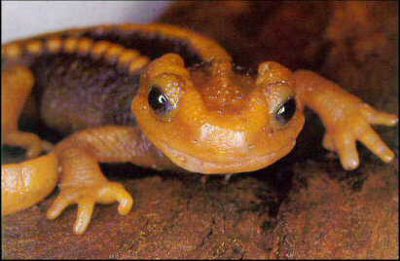Himalayan Crocodile Newt
Category: Other Amphibians

Facts about Himalayan Crocodile Newt. "Scientific name for Himalayan Crocodile Newt Tylototriton verrucosus". The Himalayan Crocodile Newt is a breed of newt found largely in Southeast Asia and in the Indian Subcontinent.
Appearance of Himalayan Crocodile Newt
The Himalayan Crocodile Newt appears with the body length of (20 cm). It has a small tongue and is free on the sides and only somewhat towards its base. The palate teeth are in two slanting rows that assemble at the front of the mouth. The head of the Himalayan Crocodile Newt has a broad, bony fronto-squamosal and the nose is short. The nose of the Himalayan Crocodile Newt is short and the head is wide and has three high-flying bony ridges with pores, two along the back of the sides and one along the center of the head. These Himalayan Crocodile Newt breeds have five toes and the tail is compacted to assist swimming.
Features of Himalayan Crocodile Newt
The lips of the Himalayan Crocodile Newt have no lobes and the body length ranges from 3 to 3.5 times as elongated as the head. The dorsal midrib has no crest as in a few newts, but there is an outstanding vertebral ridge with a sequence of knobs bent from the growth of the neural courses of the dorsal vertebrae bones. There is a chain of 15 or 16 porous glands similar to knobs along the sides with the last three at the back of the leg.
The legs are fairly long with the toes and fingers, but they are somewhat flattened. The tail of the Himalayan Crocodile Newt is at least as long as the body and head, and is flattened to assist in swimming. The tail has a lower and an upper crest, which assemble at the tail tip. The anal gap is a longitudinal cut, and its edges are not raised. The skin of the Himalayan Crocodile Newt is hard and it has large parotoid glands. The Himalayan Crocodile Newt has a strong fold on the cheek.
Color of Himalayan Crocodile Newt
The Himalayan Crocodile Newt is consistently blackish brown, somewhat paler on the nose, lips, cheek, gullet, and under surface of limbs. The lower tip of the tail is orange-yellow in color.
Diet of Himalayan Crocodile Newt
The Himalayan Crocodile Newt feeds on worms, spiders, millipedes, mollusks, scorpions and a variety of insects.
Reproduction of Himalayan Crocodile Newt
During the reproduction period in May and June the Himalayan Crocodile Newts have behavioral differences between the genders. Courtship and mating take place at nighttime and as in several salamanders engages the male, wriggling it while pushing, bending and curving its tail. The average life span of the Himalayan Crocodile Newt breed is more than 10 years.

 Back To Category Other Amphibians
Back To Category Other Amphibians